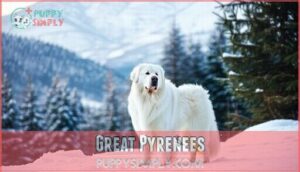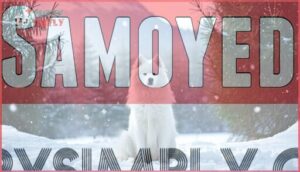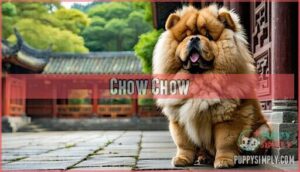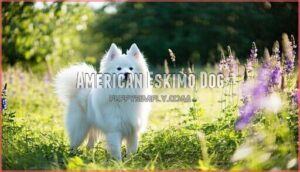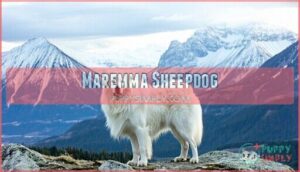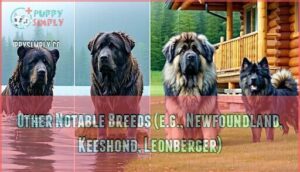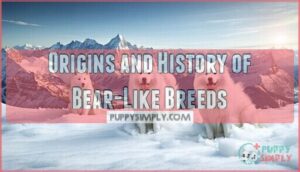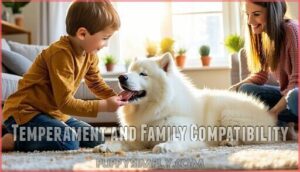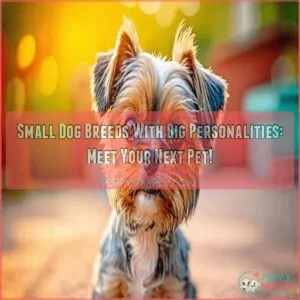This site is supported by our readers. We may earn a commission, at no cost to you, if you purchase through links.
 You’ve probably seen them at the dog park or on social media—those massive fluffy white dogs that make you do a double-take. At first glance, they look like they just wandered off an Arctic ice sheet. But these aren’t exotic wild animals. They’re domestic dog breeds with thick snowy coats and bear-like builds that have been working alongside humans for centuries.
You’ve probably seen them at the dog park or on social media—those massive fluffy white dogs that make you do a double-take. At first glance, they look like they just wandered off an Arctic ice sheet. But these aren’t exotic wild animals. They’re domestic dog breeds with thick snowy coats and bear-like builds that have been working alongside humans for centuries.
Some were bred to guard livestock in freezing mountain ranges, while others pulled sleds across frozen tundras. Their polar bear resemblance isn’t just for show—it’s the result of generations adapting to harsh climates. If you’re drawn to these majestic white giants, you’ll want to know which breeds fit the bill and what it really takes to care for them.
Table Of Contents
- Key Takeaways
- What Are Polar Bear Dog Breeds?
- Top Dog Breeds That Look Like Polar Bears
- Origins and History of Bear-Like Breeds
- Temperament and Family Compatibility
- Grooming, Care, and Health Considerations
- Frequently Asked Questions (FAQs)
- What are the grooming requirements for polar bear dog breeds?
- Are polar bear dogs hypoallergenic or good for allergies?
- Whats the lifespan of polar bear dog breeds?
- How much do these dogs typically cost to purchase?
- Can polar bear dogs live in warm climates?
- Do these breeds get along well with other pets?
- Conclusion
Key Takeaways
- These polar bear-like breeds were originally developed as working dogs in harsh climates, bred specifically for jobs like guarding livestock in mountains or pulling sleds across frozen tundras—their thick white coats and large builds aren’t just for looks but reflect centuries of adaptation to extreme weather.
- While their fluffy appearance suggests cuddle buddies, most of these breeds come with strong protective instincts and independent personalities that require early socialization and consistent training to channel their guarding behaviors appropriately around families and strangers.
- The maintenance commitment is significant—you’ll need to brush these dogs two to three times weekly to prevent matting, provide daily exercise despite their calm demeanor, and budget for potential breed-specific health issues like hip dysplasia (affecting up to 20% of Great Pyrenees) and progressive retinal atrophy.
- Despite their Arctic appearance, these breeds can adapt to various climates with proper care, but potential owners should understand they’re getting a working dog with ancient instincts rather than just a pretty pet, requiring space, dedication, and respect for their original guardian roles.
What Are Polar Bear Dog Breeds?
You’ve probably seen a fluffy white dog and thought it looked just like a miniature polar bear. Some breeds really do share that thick coat, rounded face, and cuddly appearance that makes them nearly indistinguishable from their Arctic counterparts.
Let’s look at what gives these dogs their bear-like charm and which breeds fit the description.
Defining Polar Bear-Like Dogs
A polar bear dog isn’t some mythical crossbreed—it’s just a regular dog with a thick white coat and a build that makes you do a double-take at the dog park.
These fluffy white dogs share specific physical characteristics that create their bear-like appearance:
- Dense white double coats that provide insulation and volume
- Substantial size variations ranging from medium to giant breeds
- Rounded facial features with small ears and broad muzzles
Dog breeds resembling polar bears meet these breed standards naturally through centuries of development in cold climates.
Key Physical Traits and Appearance
When you look past the fluff, these bear-like dogs share a handful of specific traits that make them stand out from your average retriever or terrier. Their coat density is off the charts—think double-layered insulation built for Arctic weather. Body size varies, but most lean toward the large end of the spectrum, with facial features like broad muzzles and small rounded ears completing the look.
These characteristics of bearlike dogs aren’t accidents—they’re breed standards developed over centuries in cold climates where fluffy white dogs needed serious protection from the elements.
| Trait | Description | Bear Connection |
|---|---|---|
| Fur Color | Pure white or cream tones | Mimics polar bear coloring |
| Coat Density | Thick double coat with soft undercoat | Provides volume and bulk |
| Facial Features | Rounded head, small ears, broad muzzle | Creates bear-like profile |
Why Some Dogs Resemble Polar Bears
These fluffy white giants didn’t evolve from polar bears—they were carefully shaped by humans. Canine evolution and selective breeding created these bearlike traits over generations. Coat genetics produced the thick double layers needed for harsh winters, while environmental factors in cold regions like northern Russia and the Arctic drove breed standards toward insulation and bulk.
Geographic isolation and specific working roles cemented these dog breed characteristics. Many of these breeds have a thick and fluffy coat, requiring regular grooming. The result? Dog breeds resembling polar bears through pure human design, not direct genetic ancestry with actual bears.
Top Dog Breeds That Look Like Polar Bears
If you’re looking for dogs that could pass for miniature polar bears, you’re in for a treat. Several breeds have that fluffy white coat and bear-like build that makes them look like they just wandered off an Arctic ice shelf.
Let’s take a look at the top breeds that fit the bill.
Great Pyrenees
With a build that rivals a polar bear and a coat as white as fresh snow, the Great Pyrenees looks like it just wandered off an Arctic ice shelf and into your backyard. Originally bred in the Pyrenees mountains, these livestock guardians protected flocks with unwavering dedication. Their white double coat blends beautifully with sheep while offering weather protection.
Today, these gentle giants make wonderful family pets, though their herding history means they’re naturally watchful. Key breed characteristics include:
- Zen-like patience with children and other animals
- Dirt-resistant coat requiring minimal grooming despite thickness
- Protective instincts balanced with calm temperament
- Large size averaging 85-115 pounds at maturity
- Independent thinking from guardian background
Despite their impressive appearance, Pyrenees temperament leans mellow. Regular coat care and monitoring breed health issues like hip dysplasia keeps these dog breeds resembling bears thriving.
Samoyed
Picture a cloud that learned to smile—that’s basically what you’re getting with a Samoyed. This Arctic-looking dog hails from northern Russia, where they herded reindeer and pulled sleds through brutal winters. Their luxurious white double coat feels like angora and needs regular brushing to prevent matting. Family compatibility? Exceptional. Samoyed temperament thrives on interaction with devoted owners.
| Breed Aspect | Details |
|---|---|
| Origin | Northern Russia, reindeer herding |
| Coat Type | Thick white double coat |
| Grooming Needs | Regular brushing required |
| Temperament | Family-friendly, social |
Chow Chow
If your dog could rock a lion’s mane and sport a purple tongue, you’d have a Chow Chow on your hands. These bear-like dogs trace back to China’s Tang Dynasty, where they guarded temples and hauled goods. Their massive bushy ruff gives them that distinctive teddy bear look.
Chow Chows bond deeply with their families but show an independent spirit around strangers. You’ll need twice-weekly brushing and monthly baths to keep that thick coat looking sharp.
American Eskimo Dog
Originally known as the German Spitz, this striking white dog got an all-American makeover during World War I and never looked back. These family-friendly companions sport a polar bear-like double coat and love being part of the action.
Quick Facts About American Eskimo Dogs:
- Spitz heritage shines through their fluffy white coat and alert, fox-like expression
- Shedding frequency is nearly constant, requiring brushing two to three times weekly
- Family suitability ranks high since they’re naturally social and thrive on interaction
- Exercise needs include daily walks and playtime to keep them mentally sharp
- Eskie coat care involves regular grooming to manage their beautiful but demanding fur
Maremma Sheepdog
This Italian herding breed was literally born to blend in with sheep while keeping wolves at bay in the rugged mountains. Their dense white coat needs surprisingly little grooming, and they’re deeply devoted to their family but need a real job to feel fulfilled.
| Maremma Sheepdog Trait | Details |
|---|---|
| Italian Origins | Bred in Italy as livestock guardian |
| Wolf Protection | Natural instinct to guard flocks |
| Breed Purpose | Working livestock guard dogs, not just pets |
| Low Maintenance | Occasional brushing keeps coat healthy |
| Family Bond | Protective dog breeds with strong devotion |
Other Notable Breeds (e.g., Newfoundland, Keeshond, Leonberger)
Beyond the main white fluffy giants, several dog breeds resembling bears stand out. Newfoundlands bring that gentle-bear vibe with their massive 100–150 pound frames and webbed feet built for water rescue. Then there’s the Leonberger, tipping the scales at 120–170 pounds with a lion-like mane that screams teddy bear. For something smaller, the Keeshond offers a medium-sized option at 40–45 pounds with incredibly furry faces and plumed tails. Some breeds, like the Caucasian Shepherd, have a bear-like appearance due to their thick coats and large size.
- Newfoundlands: Known for swimming ability and calm temperament traits, but watch for hip dysplasia (affects 17% of the breed)
- Leonbergers: Adaptable working dogs with waterproof coats and significant training needs due to their size
- Keeshonds: Intelligent watchdogs with 12–15 year lifespans and moderate health concerns
- Coat colors: Range from pure white to grey, black, and brown depending on bearlike dogs you choose
Origins and History of Bear-Like Breeds
These fluffy white giants didn’t just show up looking adorable—they earned their keep through centuries of hard work in some of the toughest environments on Earth.
From snowy mountain ranges to frozen tundras, each breed was shaped by the job it needed to do and the place it called home.
Let’s look at where these bear-like dogs come from and what they were originally bred to accomplish.
Ancient Guardians and Working Dogs
Many bear-like dog breeds started as livestock guardians and working companions. The Tibetan Mastiff protected monasteries in the Himalayas for over 2,000 years, while Rottweilers have drover origins dating back to Roman times.
Great Pyrenees excelled at predator deterrence in France since the 15th century, and Karelian Bear Dogs were specifically bred for bear hunting in Finland.
These protective dog breeds weren’t just companions—they were essential partners in survival.
Geographic Roots and Purpose
From the snowy peaks of the Pyrenees to the frozen tundras of Siberia, these fluffy giants developed in some of the harshest climates on Earth. Each region shaped its dogs differently based on what people needed.
- Samoyeds from Russia pulled sleds and herded reindeer across icy landscapes
- Great Pyrenees evolved in the mountains between France and Spain as livestock guard dogs
- Maremma Sheepdogs were purposefully bred in Italy to protect flocks from wolves
This regional variation explains why dog breeds from Russia excel in cold tolerance while mountain ancestry breeds like the Estrela developed amazing endurance.
Noteworthy Historical Roles
These bear-like dogs didn’t just look impressive—they actually saved lives, guarded emperors, and worked alongside humans in ways that shaped entire communities. Chow Chows protected Chinese temples during the Tang dynasty, while Newfoundlands performed daring water rescues. Samoyeds became invaluable sled-pulling partners in Arctic expeditions, and Great Pyrenees defended royal estates across Europe.
| Breed | Historical Role | Notable Use |
|---|---|---|
| Chow Chow | Ancient Guardians | Temple protection and royal companions in China |
| Newfoundland | War Dogs & Rescue | Search-and-rescue missions and military support |
| Great Pyrenees | Livestock Guard Dog | Protected French royalty and mountain flocks |
These working dog breeds proved their herding heritage and loyalty shaped entire civilizations.
Temperament and Family Compatibility
Just because these fluffy white dogs look like cuddly polar bears doesn’t mean they all act the same around families. Their personalities range from patient protectors to social butterflies, and understanding what makes each breed tick helps you pick the right fit for your home.
Let’s look at how these bear-like breeds approach family life, strangers, and the training they need to thrive.
Protective Instincts and Loyalty
If you’ve ever wondered whether your fluffy white dog could double as a security system, you’re onto something—breeds that resemble polar bears often come hardwired with protective instincts that have been honed over centuries of guarding livestock and families. Their loyalty challenges stem from this deep-rooted devotion. These guard dogs bond intensely with their people, making them superb family pets when socialized properly.
Here’s what you’ll notice about their guarding behaviors:
- They’re naturally territorial – Your Great Pyrenees or Maremma won’t need training to patrol your property at night.
- Strangers get the side-eye – Chow Chows show breed devotion by being standoffish with unfamiliar faces while staying loving with family.
- Their protective instinct kicks in automatically – These protective breeds assess threats constantly, which means family protection comes naturally but requires proper channeling through training.
Social and Family-Friendly Traits
While polar bear-like breeds pack serious guarding muscle, most of them turn into total softies around their families—think gentle giant who’ll let your toddler use them as a pillow while still keeping a watchful eye on the backyard.
Samoyeds and American Eskimo Dogs show high playfulness levels and thrive on child interaction, making them excellent family-friendly dog breeds. Their dog personalities blend patience with energy, requiring moderate exercise needs daily.
Early socialization importance can’t be overstated—it shapes positive dog behavior and ensures smooth family integration, letting these dogs’ sweet temperament shine through.
Training and Socialization Needs
Training a polar bear look-alike takes patience and a game plan, because their independent streak and protective instincts can make them a bit stubborn if you skip the early groundwork.
Early socialization shapes dog behavior and prevents behavioral challenges like wariness around strangers. Obedience training works best with positive reinforcement—these breeds respond better to treats and praise than harsh corrections.
Breed-specific training targets their guarding instincts, helping channel protective energy into appropriate dog characteristics rather than overprotective reactions.
Grooming, Care, and Health Considerations
Owning a polar bear dog comes with some real responsibilities. These fluffy giants need consistent grooming to keep their coats healthy and they require more exercise than you might think.
Let’s look at what it takes to keep these beautiful breeds in top shape.
Coat Maintenance and Grooming Routines
That gorgeous fluffy coat you fell in love with doesn’t maintain itself, and grooming bear-like breeds takes real commitment. You’ll need to brush these dogs two to three times weekly to prevent matting and control shedding.
Most need monthly bathing with detangling shampoo to keep their coats looking immaculate. Some owners rely on professional grooming every few months for thorough coat maintenance.
Exercise and Activity Requirements
Don’t let that fluffy coat fool you—these bear-like dogs need serious exercise to stay healthy and happy. Most require daily walks plus active playtime to manage their energy levels.
Great Pyrenees enjoy moderate hikes, while Samoyeds thrive with vigorous activities like running or agility training. Mental stimulation through puzzle toys prevents boredom.
Consider your dog’s size and breed-specific needs when planning activities.
Common Health Issues in Bear-Like Breeds
Your fluffy companion may face specific dog health challenges tied to their breed. Genetic predispositions play a big role—these bear-like dogs inherit certain breed-specific ailments more often than other breeds. Understanding dog breed health considerations helps you catch problems early and take preventative measures.
Watch for these common dog breed health issues:
- Hip dysplasia and bone problems – Up to 20% of Great Pyrenees develop hip dysplasia, while large breeds like Leonbergers face higher osteosarcoma risk requiring early detection of lameness.
- Eye conditions – Samoyeds and Karelian Bear Dogs commonly experience progressive retinal atrophy and cataracts, with incidence rates reaching 7-12% depending on pedigree.
- Heart and endocrine disorders – Dilated cardiomyopathy affects over 5% of Great Pyrenees and Leonbergers, while Addison’s disease appears more frequently in these breeds than the general dog population.
Veterinary advances in genetic screening now help responsible breeders reduce inherited conditions. Regular vet checkups, proper nutrition, and monitoring for breed-specific symptoms are essential parts of dog health and care. Early detection makes a huge difference in managing these dog breed characteristics effectively.
Frequently Asked Questions (FAQs)
What are the grooming requirements for polar bear dog breeds?
Brushing your dog’s coat two to three times weekly prevents matting and controls shedding. Bathe monthly using detangling shampoo, trim nails regularly, and consider professional grooming for thick double coats.
Are polar bear dogs hypoallergenic or good for allergies?
Unfortunately, no polar bear dog breeds are hypoallergenic. All produce dander and saliva allergens that trigger reactions.
Their heavy shedding and thick white dog coats worsen allergy triggers, making managing allergies challenging for sensitive individuals.
Whats the lifespan of polar bear dog breeds?
Breed longevity in dog breeds that resemble bears usually ranges from 10 to 13 years.
Though dog size plays a role—larger breeds often have shorter lifespans due to genetic factors and faster aging, while healthcare impact and diet influence can extend their years considerably.
How much do these dogs typically cost to purchase?
You know the saying: "Good things don’t come cheap." Initial puppy cost for these bear-like dog breeds ranges from $1,500 to $8,000.
Breed popularity drives prices up—Samoyeds often hit the higher end while adoption options can save you thousands.
Can polar bear dogs live in warm climates?
These white dog breeds can adapt to warmer climates with proper care. You’ll need to provide shade, plenty of water, and exercise during cooler morning or evening hours.
Their thick double coats offer some heat tolerance through insulation.
Do these breeds get along well with other pets?
Breed compatibility varies widely among these canine companions. Some family-friendly dog breeds naturally welcome other pets with proper socialization and early exposure.
Territorial behavior can emerge in guard-oriented types without training, impacting their dog breed temperament and behavior.
Conclusion
These polar bear dog breeds prove that gentle giants can be fierce protectors. Their thick white coats weren’t designed for Instagram—they evolved to survive brutal winters while guarding flocks.
Whether you’re drawn to a Samoyed’s smile or a Great Pyrenees’ calm presence, owning one means committing to serious grooming and exercise. They aren’t just pets. They’re working dogs with ancient instincts.
But if you’ve got the space and dedication, these majestic animals reward you with loyalty that’s hard to match.

